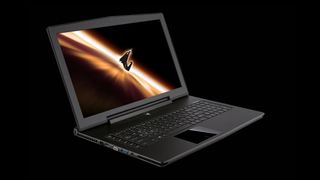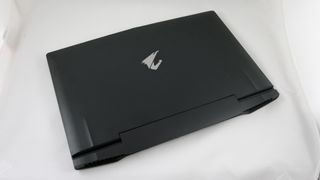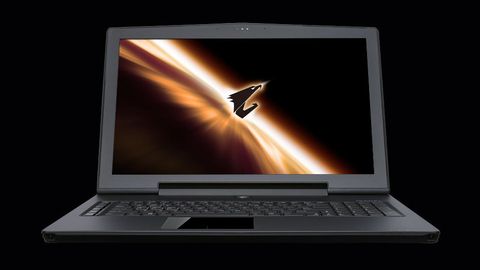Why you can trust TechRadar
- Cinebench 11.5
- OpenGL 60.74fps
- CPU 6.96
- 3D Mark Ice 121671; Cloud 17293; Fire 4220
- Battery Eater Pro: 122 mins
So, the Aorus X7 is a bit of a beast. Really, given the spec list, this shouldn't come as a surprise – but here it's confirmed. The X7 isn't just powerful for a laptop that's an inch thick – it's just plain powerful.
The twin Nvidia 765M GPUs do very well in benchmarks, comfortably beating out the single 770M in the likes of the Gigabyte P25W and Toshiba Qosmio X70, but bested by the single 780M used in the Schenker XMG P503.
But that's in benchmarks – in the real world, performance is even better. Just about everything we threw at it played as smoothly as you'd hope, but the headline is that BioShock Infinite, with everything maxed, achieved 55 frames per second average at 1080p. The XMG P503, which its 780M card, achieved 45 frames per second.

The occasional uncertainty of SLI means that this kind of performance increase won't be true of every game, but it's fair to say that Aorus has met its target of 780M-equalling performance (provided you remember to turn on both GPUs – only one is active by default).
Of course, this amount of power is great outside of games, too – with 4GB of GDDR5 RAM on offer, it's a great portable option for anyone who needs 3D power for pro graphics applications. That said, if a thin 3D machine is what you're after, there's a new ultrabook workstation contender in the form of the HP ZBook 14, which offers an AMD FirePro workstation-class GPU.
The CPU scores basically as expected in its own benchmarks, matching performance in most of the other laptops we've already mentioned, as well as the HP TouchSmart 15. It's a very capable chip, and though it isn't from the absolutely highest end, it's really more than powerful enough for both gaming and even most pro applications – let alone just general browsing and video use.
The mSATA SSD in our review model meant that performance when using Windows was very good for the most part, as was booting up. And, unsurprisingly, 16GB of RAM meant that we didn't exactly see a lot of slow-down from having lots of applications open.
Keyboard and trackpad
But we knew it would be a good performer – what surprised us was how good the usability was in general. The keyboard is truly excellent, with crisp, responsive keys that give plenty of feedback when typing. The travel is a tiny bit short for our liking, but that's just nit-picking – and gamers may prefer the shorter press anyway.
The trackpad is nice and responsive, and works really well, but does have one significant downside – it's glossy glass, and it picks up fingerprints and grease to a comical degree. And it's not just an aesthetic thing – it actually gets in the way of using it, causing friction or the responsiveness to drop. OK, for gaming, you're probably going to be using a mouse or controller, but we wish the trackpad was a little nicer.
The screen is decent, but nothing to get excited about. Using a good-quality TN panel means good response rates for gaming, but colour reproduction and viewing angles are merely nice, rather than great (or any further superlatives).
One area where, perhaps predictably, usability suffers a little is in the noise levels from the fan. With one GPU under load it's not bad at all – a high hiss that can be drowned out without too much difficulty. With both GPUs at full load, though, it's a different story.
Yeah, it's pretty loud. And you can feel air blasting almost a foot out of the side vents. It's great that they're doing their job, but you'll certainly know about it.
This perhaps explains why Aorus has put some of the world's loudest speakers in this machine. They're decent, but the overriding impression is that, boy, can they go loud.

Aorus has included some software extras, and that's not as terrible a thing as it often is with laptops. There's a menu that makes it fast and easy to adjust some settings, and provides access to things like different fan profiles, so you can actually manage the potential noise levels. It's all very thoughtful stuff.
Finally, we expected battery life to be fairly poor, and it was. But it wasn't as bad as we thought – we've seen a lot worse in gaming machines. Two hours in our intense battery tests isn't great, but it means that you could easily watch a film on battery power.

Researchers produce thinnest sheet of metal ever using a 100-year old Japanese technique — Goldene could pave way for super catalysts, ultra high density optical storage and much more

Thomas & Uber Cup live stream 2024: how to watch badminton FREE online

A mystery Wear OS watch has just surfaced as the Pixel Watch 3 gets closer
